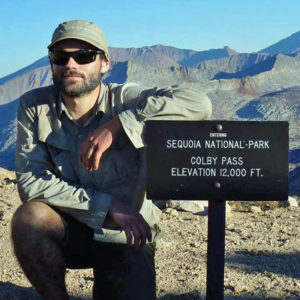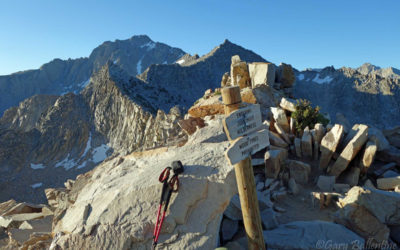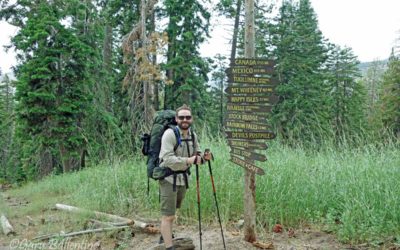A Guide to Hiking the John Muir Trail
The John Muir Trail is the crown jewel of California’s High Sierra, spanning 220 miles of granite peaks, alpine meadows, conifer forests, and what is arguably the most breathtaking mountain scenery in North America. The trail passes hundreds—if not thousands—of pristine mountain lakes, crosses 11 mountain passes, and leads you to the summit of the tallest mountain in the contiguous United States, Mt. Whitney. It is a through-hiker’s dream, as its constantly changing scenery makes each day an adventure that you will never forget.
Location Yosemite to Mt. Whitney, California
Length 220 Miles
Duration 18-22 days (average)
Difficulty Difficult-Strenuous but Non-Technical
Season July Through September, Conditions Permitting
Elevation 4,000 to 14,505 Feet
Total Elevation Gain 47,000 Feet
Total Passes 11
Fires Allowed Variable
Water Availability Abundant
Weather Highly Variable but Often Sunny
Permit Required Yes
What Hiking the John Muir Trail is Like
The John Muir Trail is subject to wildly and rapidly changing landscapes, and each day you will see something new that completely blows you away. You start off in a conifer forest deep in Yosemite Valley, ascend 6,000 feet your first day past epic waterfalls, and constantly weave in and out of pine trees, alpine peaks, mountain meadows, high elevation passes, flowing rivers, and majestic lakes for the entire 220 miles.
There is not a single boring moment on the trail, and when the landscape isn’t leaving you speechless, you will find plenty of opportunities to make friends with fellow hikers. The trail is heavily-trafficked, but the quota system keeps it manageable. Several side-hikes are present along the entire trail, and often stepping just a few hundred yards away will yield you with tremendous solitude and unlimited opportunities to explore some of the most remote wilderness in the contiguous United States.
How Long Does it Take?
The average is 18-22 days, but ultralight fast-packers complete the trail in as little as 10 days. This means hiking 22 miles per day though, which is unattainable for most people. Averaging 10-12 miles per day, including rest days, is more in line with what the typical hiker is capable of, and that puts you at 18-22 days. I have personally completed the trail in 16 and 18 days while completing several side hikes, and next time I will give myself more time to take in the sights.
How Hard is the John Muir Trail?
The John Muir Trail gains a total of 47,000 feet and crosses 11 mountain passes, 6 of which are over 11,000 feet in elevation. The trail itself is very well maintained, but you will need to carry several days worth of food, making slogs up the passes difficult. The grades going up the passes are moderate as switchbacks abound, but the elevation and thin air will take their toll until you acclimate. For this reason, hiking from north to south is considered easier, as you begin at lower elevation and gradually work your way up to Mt. Whitney.
When Should I Hike the John Muir Trail?
The best time to hike the John Muir Trail is usually early July through the end of September, but this can vary wildly from year to year due to snowpack. Much of the trail is very high elevation and receives significant winter snowfall, with some sections remaining buried 9 months or more each year. During normal years, the trail becomes passable without significant snow travel in early July, but in heavy snow years, long stretches remain buried until August.
Early season conditions bring endless wildflowers, fewer people, wet meadows, deep water crossings, and mosquitos that will blot out the sun. You will hike in the shade! By late season, almost all of the snow has melted, the mosquitos have all died, the crowds have mostly gone, and the wildflowers have withered away. Mid-season is arguably the glory season, where you get a mix of early and late season conditions.
How Do I Get a Permit for the John Muir Trail?
The John Muir Trail is subject to a quota system to limit human impact and preserve the wilderness experience. No more than 45 people are allowed to begin the trail each day inside Yosemite, and even fewer can start at the official trailhead in the valley. Because of this, you need to apply for your permit 168 days in advance. Learn how to get a permit here.
Everything you Need to Know About the John Muir Trail
6 Amazing John Muir Trail Section Hikes
6 must-see section hikes on the John Muir Trail
8 Backpacking Alternatives to the John Muir Trail
8 epic High Sierra backpacking trips
Alternative Starting Trailheads for the John Muir Trail
6 starting points for the Johh Muir Trail that are easy to get permits for
How to Start Planning a John Muir Trail Hike
Not sure where to begin? Just follow these steps!
How to Deal with Blisters On the Trail
How to treat and prevent blisters when you’re 100 miles from the car
Backpacking Water Treatment Guide
The best methods for treating water, when to use them, and why
Backpacking Footwear Guide
Everything you need to know about footwear for hiking
How Much Your Pack Should Weigh
What you should know about pack weight and how to make yours lighter
Understanding Weather and Trail Conditions in the High Sierra
A guide to weather, conditions, and what to expect in the High Sierra
John Muir Trail Etiquette, Ethics, and Leave No Trace
Everything you need to know to be a responsible hiker on the John Muir Trail
John Muir Trail Transportation Guide
Travel logistics and how to get to and from the John Muir Trail
How to Resupply on the John Muir Trail
How to resupply on the John Muir Trail
What Food to Bring on the John Muir Trail
Food suggestions and how to carry enough without being weighed down
What Gear to Bring on the John Muir Trail
What gear you need on the John Muir Trail and why
How to Get a JMT Hiking Permit
How to get a permit for hiking the John Muir Trail














